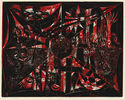
19th, 20th & 21st Century Fine Prints
707-546-7352 · fax 707-546-7924 · web: www.annexgalleries.com · email: artannex@aol.com
Tunde Odunlade Biography
Tunde Odunlade
Nigerian
1954
Biography
Nigerian printmaker, textile artist, musician, and actor Tunde Odunlade was born Babatunde Samuel Odunlade in Iremo, Ifé on November 26, 1954. He became a second-generation member of the Oshogbo School of Arts* in the late 1960s, studying under Yinka Adeyemi, and also took classes at the Oguntimehim Art-Workshop at the University of Ilé-Ifé in 1973. In both of these institutions he learned linocut, woodcut, and batiking. The latter would inspire his development of a technique he refers to as "floatagraph", creating batiked and marbelized compositions on rice paper. He was also a member of the Nigerian National Troop and other theatrical organization, and is a recording artist and poet.
From 1986 to 1989 Odunlade was artist-in-residence at Stillman College in Tuscaloosa, Alabama, and served as artistic director at the Toki Memorial Arts Center in Ibadan, Oyo, after his residency ended. He founded the International Campaign for Better Arts and Cultural Awareness in the 1990s, and in 2020 he established the Tunde Odunlade Artists Cooperative Gallery in Ibadan. In addition to working as an artist and arts teacher, Odunlade is involved with organizations aimed toward improving Nigerian life; particularly, with the Nigerian Artists for a Nation Anew (NAFANA), which encourages artists to use their talents to overcome corruption and poverty.
Odunlade's work is held in collections the world over, including the Smithsonian Museum of Africa Art, Washington, D.C.; the Jordan National Gallery of Fine Art, Amman, Jordan; the Victoria and Albert Museum, London; the MacArthur Foundation Collection, Chicago; and the State House in Lagos, Nigeria, among others. He currently lives in Ibadan, Oyo State, Nigeria, and continues to work and exhibit in Nigeria and beyond.
Selected Exhibitions:
2014: City Lights Gallery, Bridgeport, CT; Master Artist Workshop, in collaboration with the Smisonian National Museum of African Art, Bowie State University, MD
2013: 65th Anniversary of the University of Ibadan Convocation, Oyo State, Ibadan, Nigeria (commissioned exhibition); Hudson Gallery, Sylviana, OH (group show)
2012: African Anerican Art and Cultural Center, Albuquerque, NM; Rotunda Art Gallery, Office of the Governor, Santa Fe, NM; Lagos Art Expo, National Museum, Lagos, Nigeria; City Lights Gallery, Bridgeport, Connecticut
2011: "Art as a Tool for Nation Building", Nigerian High Commission, Ottawa, Canada; "New York Summer Show 2011", Corrine Jennings Gallery, New York, NY
2010: "Dreaming Between Worlds", Hammonds House Museum, Atlanta, Georgia
1999: "New Colours from Old Works: Contemporary Art from West Africa", October Gallery, London; "Beauty Ravishes Me All Over Where I Find It", October Gallery
1981, '82: Education Center, Ministry of Education, Maiduguri
1978, '80, '81: Federal Governement College, Sokoto
1978: Bakolori Dam Project, Talata, Mafara, Sokoto
The artist has a blog that incudes biography and CV pages, which can be found here.
*A note on the Oshogbo School of Arts:
Between 1962 and 1966, after Nigeria gained Independence from Britain, a group of artists emerged in the Yoruba town of Oshogbo in southwestern Nigeria. They participated in art workshops conducted by expatriates, particularly Susanne Wenger, Ulli Beier and Georgina Beier. The artists combined traditional subject matter and stories with Western artistic media and techniques. Many had been involved in dance, theater and music as members of Duro Ladipo’s theatre company and remained creatively linked. Their works were characterized as trans-genre and retained the performative momentum of Gesamtkunstwerk (total artwork). The artists, among them Jacob Afolabi, Rufus Ogundele, Jimoh Buraimoh, Adebisi Fabunmi, Taiwo Olanyi (Twins Seven-Seven), Muraina Oyelami, Adebisi Akanji, Buraimoh Gbadamosi and Nike Okundaye, gained international fame and patronage, continuing with their work even after the Beiers left Nigeria. The Beiers continued to support Oshogbo artists in Sydney, Australia and Bayreuth, Germany while Susanne Wenger involved them in the artistic recreation of the Osun grove in Oshogbo itself.
In the early 1960s, three expatriate artists, the art critic Ulli Beier (1922–2011), and visual artists Georgina Betts (later Beier, b. 1936) and Susanne Wenger (Beier’s first wife, 1915–2009) settled around Oshogbo, setting an art movement in motion. At the same time playwright Duro Ladipo (1931–1978) arrived with his theatre group. In March 1962, Ladipo opened up his home as a cultural center housing the Oshogbo chapter of Mbari Mbayo (an outgrowth of an arts organization originating at the University of Ibadan) in his “Popular Bar.” (source: Routlidge Encyclopedia of Modernism)

